A Decision Support System Tool to Manage the Flexibility in Renewable Energy-Based Power Systems
Abstract
1. Introduction
2. The PLANET Solution: System Architecture
- The user interface and orchestration module: the Integrated Decision Support System and Orchestration Cockpit (IDOC) component;
- Energy Demand, Supply, and Asset (P2G, P2H, VES) modules;
- The optimization module: District-level Storage/Conversion Coordination Engine (SCCE) module;
- The Grid Simulation component.
2.1. The PLANET DSS ICT Tool
2.1.1. PLANET Middleware
- it is currently used to set up simulators as devices, in such a way that the operator is able to select between different simulator providers. After its configuration, the middleware routes the simulation control commands from the PLANET IDOC (web-app UI) to the preconfigured simulator;
- in the next PLANET prototype, it will be used to route the communications between the central simulator that calculates the power flow of the grid section under investigation and the remote simulators that model the operation of the P2X and VES units, that is, it will a) transmit flexibility information from the unit models to the central simulator and b) receive unit operating points from the SCCE. Once this has been achieved, the “co-simulation” scenarios that implement an envisioned real-world system operation will be tested and evaluated.
2.1.2. Backend Orchestration Scripts
- scripts that can be used to retrieve topology information about the grid and the energy resources connected to the grid nodes. This information is created by the user, via the IDOC UI, and the scripts translate these parameters into properly structured files (JavaScript Object Notation JSON) that are then used by the simulator;
- scripts that can be used to retrieve uncontrollable electricity and heat demands and formulate them according to the simulation time-step and horizon that the user selects via the UI. These files are currently stored statically in the backend of the platform. This information is supposed to be provided by the Distribution System Operators of electric and heat networks (DSO-e, DSO-h). For the grid-planning use of the PLANET system, this information comes from historical measurements covering a timespan of one year. It has been envisioned that for the operational use, these files will be dynamically created, as outputs of the load (heat and electricity) forecasting algorithms that the DSOs employ;
- scripts that can be used to retrieve meteorological, photovoltaic (PV), and Wind turbine generation data utilizing the renewable.ninja service [30] according to the location chosen by the user. The scripts retrieve the physical and operating characteristics of the PV and wind turbines that may be connected to the electric branch nodes and create the request according to the appropriate structure dictated by the renewables.ninja Application Program Interface (API). The results are then stored in the PLANET DB for use by the simulator. The RES parameters and their connection nodes are specified by the user, via the IDOC UI, as part of the simulation scenario creation process;
- scripts that can be used to retrieve simulation results and (a) present them to the user via visualizations and charts and (b) store them in the PLANET MongoDB database. Other scripts that fall into the same category are the ones that handle the comparison of results from two or more previously executed simulations.
2.1.3. Frontend Web User Interface
- scenario creator: in this UI section, the user is able to create a simulation scenario in a step-by-step manner so as to avoid overloading the user. The scenario includes the name, description, the selection of the electric grid template from those already stored in the system (provided by the DSOs), the adding, editing, and deleting of renewables, loads, and flexibility units at each grid node, the editing of the properties of each of the aforementioned technologies, and the adding of economic parameters regarding the CAPEX and OPEX of the units, as well as emissions-related costs;
- simulation execution: in this section, the user is able to select a previously created scenario and instruct the remote simulator to execute it. This is done via the previously mentioned backend scripts. After the simulation has been performed, the results are visualized for the user. The results include energy flows between the energy networks, the power timeseries values and energy values over the entire simulation horizon, economic results (e.g., Levelized Cost of Electricity (LCOE)), carbon dioxide (CO2) emissions, and the Simple Payback period (SP) of the technologies;
- simulation comparison: in this section, the user is able to select two or more previously run simulations and compare the results.
3. Flexibility in the PLANET Architecture
- pure load units (e.g., Electric vehicle charging stations [33]) can provide positive and negative flexibility by increasing/decreasing their electric load;
- energy storage systems can offer positive flexibility by absorbing energy from the grid or negative flexibility by releasing stored energy [34];
- energy conversion units (P2G, P2H) can offer both positive and negative flexibility by modifying their operation set-points [35];
- generation units (e.g., Combined Heat and Power CHP) can increase/decrease the power introduced into the network and they therefore offer flexibility [36];
- [MWh] is the internal storage capacity (, for a non-buffered unit);
- is the normalized State of Charge;
- [MW] is the electric consumption of the device and is the charging/conversion efficiency;
- [MW] is the electric generation of the device and is its efficiency;
- [MW] is the energy flow that exits the system ( e.g., Synthetic Natural Gas SNG, heat) or the energy flow that enters into the system (, e.g., Natural Gas NG, wind energy) by the device;
- [MW] represents an unserved load (, e.g., demand curtailment) or an enforced energy loss (, e.g., RES curtailment);
- [MW] is the energy storage loss.
4. Use Case Development
4.1. The Analyzed Scenario
4.2. P2G Flexibility and the Objective Function
5. Results and Discussion
6. Conclusions
Author Contributions
Funding
Acknowledgments
Conflicts of Interest
References
- Riebeek, H.; Global warming. NASA - Earth Obs. 2010. Available online: https://earthobservatory.nasa.gov/Features/GlobalWarming/ (accessed on 8 October 2019).
- Meinshausen, M.; Meinshausen, N.; Hare, W.; Raper, S.C.; Frieler, K.; Knutti, R.; Frame, D.J.; Allen, M.R. Greenhouse-gas emission targets for limiting global warming to 2 C. Nature 2009, 458, 1158–1162. [Google Scholar] [CrossRef] [PubMed]
- European Commission. Energy Roadmap 2050; Publications Office of the European Union: Brussels, Belgium, 2012. [Google Scholar]
- 2050 Long-Term Strategy. Available online: https://ec.europa.eu/clima/policies/strategies/2050_en#tab-0-0 (accessed on 8 October 2019).
- Lehtveer, M.; Mattsson, N.; Hedenus, F. Using resource based slicing to capture the intermittency of variable renewables in energy system models. Energy Strateg. Rev. 2017, 18, 73–84. [Google Scholar] [CrossRef]
- Perera, A.T.D.; Nik, V.M.; Wickramasinghe, P.U.; Scartezzini, J. Redefining energy system flexibility for distributed energy system design. Appl. Energy 2019, 253, 113572. [Google Scholar] [CrossRef]
- Jin, X.; Mu, Y.; Jia, H.; Wu, J.; Jiang, T.; Yu, X. Dynamic economic dispatch of a hybrid energy microgrid considering building based virtual energy storage system. Appl. Energy 2017, 194, 386–398. [Google Scholar] [CrossRef]
- Liu, W.; Liu, C.; Lin, Y.; Ma, L.; Bai, K.; Wu, Y. Optimal scheduling of residential microgrids considering virtual energy storage system. Energies 2018, 11, 942. [Google Scholar] [CrossRef]
- Weiss, R.; Savolainen, J.; Peltoniemi, P.; Inkeri, E. Optimal scheduling of a P2G plant in dynamic power, regulation and gas markets. In Proceedings of the 10th International Renewable Energy Storage Conference (IRES 2016), Düsseldorf, Germany, 15–17 March 2016. [Google Scholar]
- Mazza, A.; Bompard, E.; Chicco, G. Applications of power to gas technologies in emerging electrical systems. Renew. Sustain. Energy Rev. 2018, 92, 794–806. [Google Scholar] [CrossRef]
- Pensini, A.; Rasmussen, C.N.; Kempton, W. Economic analysis of using excess renewable electricity to displace heating fuels. Appl. Energy 2014, 131, 530–543. [Google Scholar] [CrossRef]
- Badami, M.; Fambri, G. Optimising energy flows and synergies between energy networks. Energy 2019, 173, 400–412. [Google Scholar] [CrossRef]
- Mathiesen, B.V.; Lund, H.; Connolly, D.; Wenzel, H.; Østergaard, P.A.; Möller, B.; Nielsen, S.; Ridjan, I.; Karnøe, P.; Sperling, K.; et al. Smart energy systems for coherent 100% renewable energy and transport solutions. Appl. Energy 2015, 145, 139–145. [Google Scholar] [CrossRef]
- Chicco, G.; Cocina, V.; Mazza, A. Data pre-processing and representation for energy calculations in net metering conditions. In Proceedings of the 2014 IEEE International Energy Conference (ENERGYCON), Dubrovnik, Croatia, 13–16 May 2014. [Google Scholar]
- Mancarella, P. MES (multi-energy systems): An overview of concepts and evaluation models. Energy 2014, 65, 1–7. [Google Scholar] [CrossRef]
- Connolly, D.; Lund, H.; Mathiesen, B.V.; Leahy, M. A review of computer tools for analysing the integration of renewable energy into various energy systems. Appl. Energy 2010, 87, 1059–1082. [Google Scholar] [CrossRef]
- PLANET Planning and Operational Tools for Optimising Energy Flows & Synergies Between Energy Networks. Available online: https://www.h2020-planet.eu/ (accessed on 8 October 2019).
- Sinha, S.; Chandel, S.S. Review of software tools for hybrid renewable energy systems. Renew. Sustain. Energy Rev. 2014, 32, 192–205. [Google Scholar] [CrossRef]
- Van Beuzekom, I.; Gibescu, M.; Slootweg, J.G. A review of multi-energy system planning and optimization tools for sustainable urban development. In Proceedings of the 2015 IEEE Eindhoven PowerTech, Eindhoven, Netherlands, 29 June–2 July 2015. [Google Scholar]
- Bottaccioli, L.; Patti, E.; Macii, E.; Acquaviva, A. Distributed Infrastructure for Multi-Energy-Systems Modelling and Co-simulation in Urban Districts. In Proceedings of the 7th International Conference on Smart Cities and Green ICT Systems (SMARTGREENS), Funchal, Portugal, 16–18 March 2018. [Google Scholar]
- Badami, M.; Fambri, G.; Martino, M.; Papanikolaou, A. ICT optimization tool for RES integration in combined energy networks. In Proceedings of the 2018 IEEE International Telecommunications Energy Conference (INTELEC), Turin, Italy, 7–11 October 2018. [Google Scholar]
- Papanikolaou, A.; Katsiki, V.; Sideris, D.; Mazza, A.; Estebsari, A.; Mirtaheri, H.; Damousis, Y.; Kakardakos, N.; Faropoulos, J.; Skiadaresis, G. Deliverable D1.4 PLANET System Architecture Definition; PLANET, 2019. Available online: https://static1.squarespace.com/static/5a3297ded7bdce9ea2f39f1a/t/5ddd2a00c833493f056f2a08/1574775315046/D1.4_Planet_Final_PU.pdf (accessed on 8 November 2019).
- Silvennoinen, E.; Juslin, K.; Hänninen, M.; Tiihonen, O.; Kurki, J.; Porkholm, K. The APROS Software for Process Simulation and Model Development; Technical Research Centre of Finland: Espoo, Finland, 1989. [Google Scholar]
- Neo-Carbon Energy: Emission-Free Future Now Available. Available online: http://www.neocarbonenergy.fi/ (accessed on 5 December 2019).
- Mirtaheri1, H.; Bortoletto, A.; Fantino, M.; Bertone, F.; Li, Y.; Damousis, Y.; Agtzidis, D.; Katsiki, V.; Papanikolaou, A.; Schröder, A.; et al. Deliverable 3.5 District-Level Storage and Conversion Management & Coordination Engine (SCCE); PLANET, 2019. in press. Available online: https://www.h2020-planet.eu/deliverables (accessed on 8 November 2019).
- eMEGAsim, Power System and Power Electronic Real-Time Simulator, OPAL-RT. Available online: http://www.opal-rt.com/new-product/emegasim-power-system-and-power-electronic-real-time-simulator (accessed on 5 September 2018).
- Bottaccioli, L.; Estebsari, A.; Patti, E.; Pons, E.; Acquaviva, A. Planning and real-time management of smart grids with high PV penetration in Italy. Proc. Inst. Civ. Eng. Eng. Sustain. 2018, 272–282. [Google Scholar] [CrossRef]
- Bian, D.; Kuzlu, M.; Pipattanasomporn, M.; Rahman, S.; Wu, Y. Real-time co-simulation platform using OPAL-RT and OPNET for analyzing smart grid performance. In Proceedings of the 2015 IEEE Power & Energy Society General Meeting, Denver, CO, USA, 26–30 July 2015. [Google Scholar]
- Büscher, M.; Piech, K.; Lehnhoff, S.; Rohjans, S.; Steinbrink, C.; Velasquez, J.; Andren, F.; Strasser, T. Towards smart grid system validation: Integrating the SmartEST and the SESA laboratories. In Proceedings of the 2015 IEEE 24th International Symposium on Industrial Electronics (ISIE), Buzios, Brazil, 3–5 June 2015. [Google Scholar]
- Renewables.ninja. Available online: https://www.renewables.ninja/ (accessed on 8 October 2019).
- Stinner, S.; Huchtemann, K.; Müller, D. Quantifying the operational flexibility of building energy systems with thermal energy storages. Appl. Energy 2016, 181, 140–154. [Google Scholar] [CrossRef]
- De Coninck, R.; Helsen, L. Quantification of flexibility in buildings by cost curves–Methodology and application. Appl. Energy 2016, 162, 653–665. [Google Scholar] [CrossRef]
- Diaz-Londono, C.; Colangelo, L.; Ruiz, F.; Patino, D.; Novara, C.; Chicco, G. Optimal Strategy to Exploit the Flexibility of an Electric Vehicle Charging Station. Energies 2019, 12, 3834. [Google Scholar] [CrossRef]
- Mirtaheri, H.; Bortoletto, A.; Fantino, M.; Mazza, A.; Marzband, M. Optimal Planning and Operation Scheduling of Battery Storage Units in Distribution Systems. In Proceedings of the 2019 IEEE Milan PowerTech, Milan, Italy, 23–27 June 2019. [Google Scholar]
- Estermann, T.; Newborough, M.; Sterner, M. Power-to-gas systems for absorbing excess solar power in electricity distribution networks. Int. J. Hydrog. Energy 2016, 41, 13950–13959. [Google Scholar] [CrossRef]
- Kubik, M.L.; Coker, P.J.; Barlow, J.F. Increasing thermal plant flexibility in a high renewables power system. Appl. Energy 2015, 154, 102–111. [Google Scholar] [CrossRef]
- Jacobsen, H.K.; Schröder, S.T. Curtailment of renewable generation: Economic optimality and incentives. Energy Policy 2012, 49, 663–675. [Google Scholar] [CrossRef]
- Brandstätt, C.; Brunekreeft, G.; Jahnke, K. How to deal with negative power price spikes?—Flexible voluntary curtailment agreements for large-scale integration of wind. Energy Policy 2011, 39, 3732–3740. [Google Scholar] [CrossRef]
- Ulbig, A.; Andersson, G. Analyzing operational flexibility of electric power systems. Int. J. Electr. Power Energy Syst. 2015, 72, 155–164. [Google Scholar] [CrossRef]
- Heussen, K.; Koch, S.; Ulbig, A.; Andersson, G. Energy storage in power system operation: The power nodes modeling framework. In Proceedings of the 2010 IEEE PES Innovative Smart Grid Technologies Conference Europe (ISGT Europe), Gothenberg, Sweden, 11–13 October 2010. [Google Scholar]
- Heussen, K.; Koch, S.; Ulbig, A.; Andersson, G. Unified system-level modeling of intermittent renewable energy sources and energy storage for power system operation. IEEE Syst. J. 2011, 6, 140–151. [Google Scholar] [CrossRef]
- Kötter, E.; Schneider, L.; Sehnke, F.; Ohnmeiss, K.; Schröer, R. The future electric power system: Impact of Power-to-Gas by interacting with other renewable energy components. J. Energy Storage 2016, 5, 113–119. [Google Scholar] [CrossRef]
- Pleßmann, G.; Blechinger, P. How to meet EU GHG emission reduction targets? A model based decarbonization pathway for Europe’s electricity supply system until 2050. Energy Strateg. Rev. 2017, 15, 19–32. [Google Scholar] [CrossRef]
- Gutiérrez-Martín, F.; Rodriguez-Anton, L.M. Power-to-SNG technology for energy storage at large scales. Int. J. Hydrog. Energy 2016, 41, 19290–19303. [Google Scholar] [CrossRef]
- Marocco, P.; Morosanu, E.A.; Giglio, E.; Ferrero, D.; Mebrahtu, C.; Lanzini, A.; Abate, S.; Bensaid, S.; Perathoner, S.; Santarelli, M.; et al. CO2 methanation over Ni/Al hydrotalcite-derived catalyst: Experimental characterization and kinetic study. Fuel 2018, 255, 230–242. [Google Scholar] [CrossRef]
- Kersting, W.H. Distribution System Modeling and Analysis; CRC Press: Boca Raton, CA, USA, 2016. [Google Scholar]
- Barrero-González, F.; Pires, V.F.; Sousa, J.L.; Martins, J.F.; Milanés-Montero, M.I.; González-Romera, E.; Romero-Cadaval, E. Photovoltaic Power Converter Management in Unbalanced Low Voltage Networks with Ancillary Services Support. Energies 2019, 12, 972. [Google Scholar] [CrossRef]

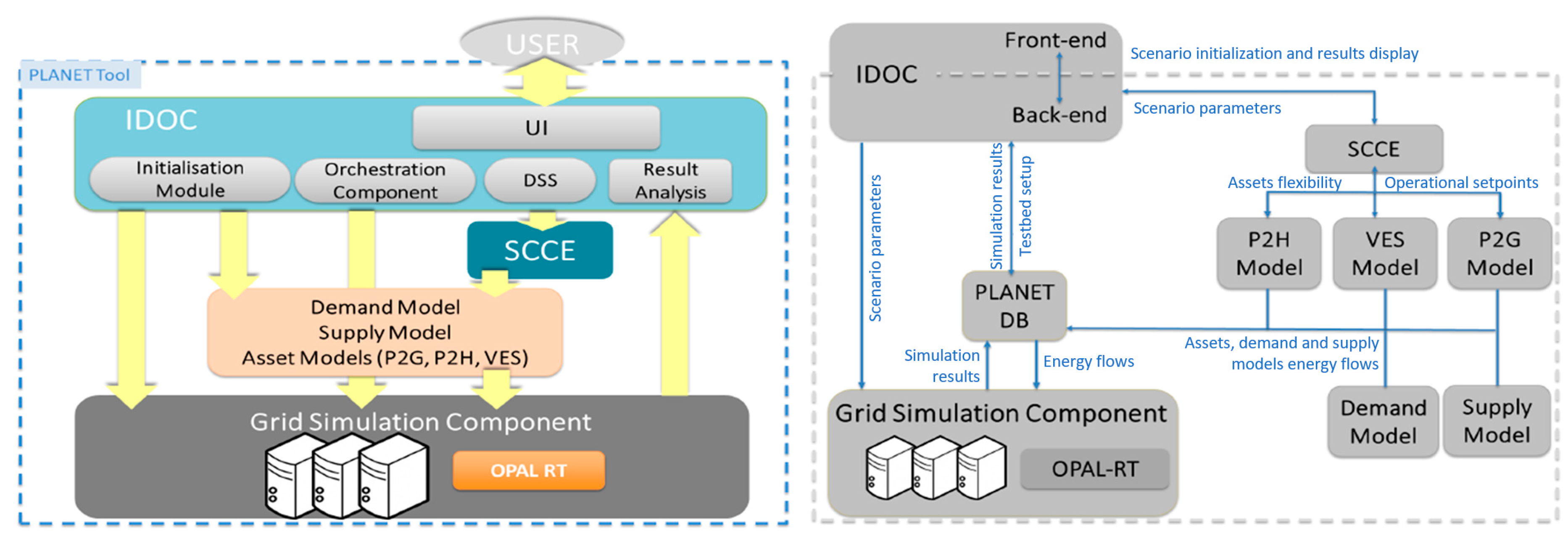
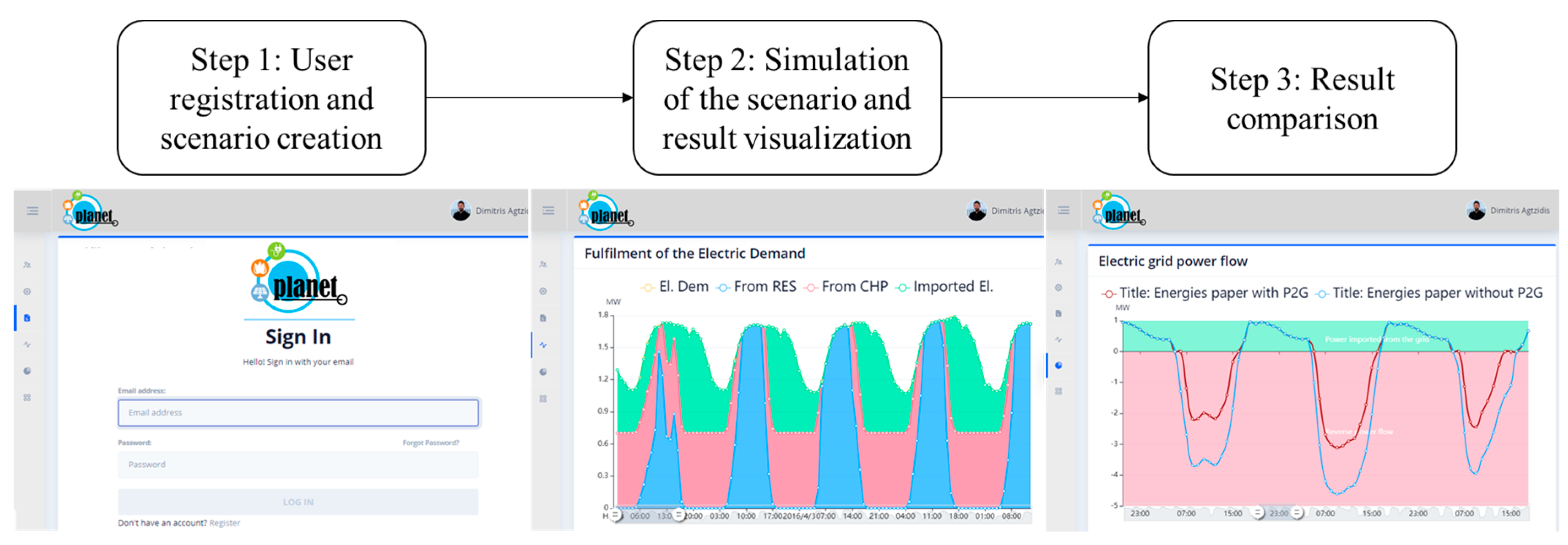

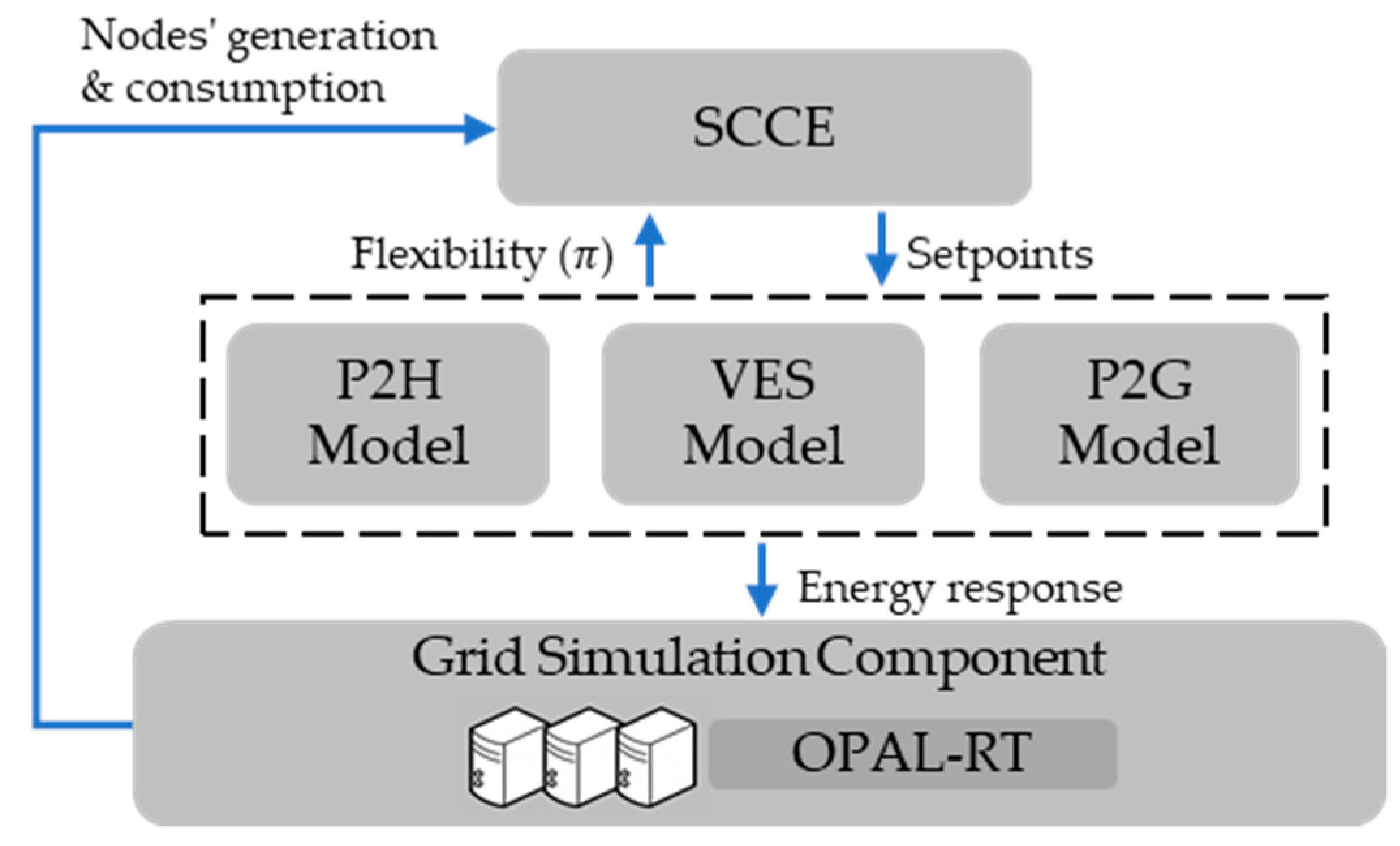

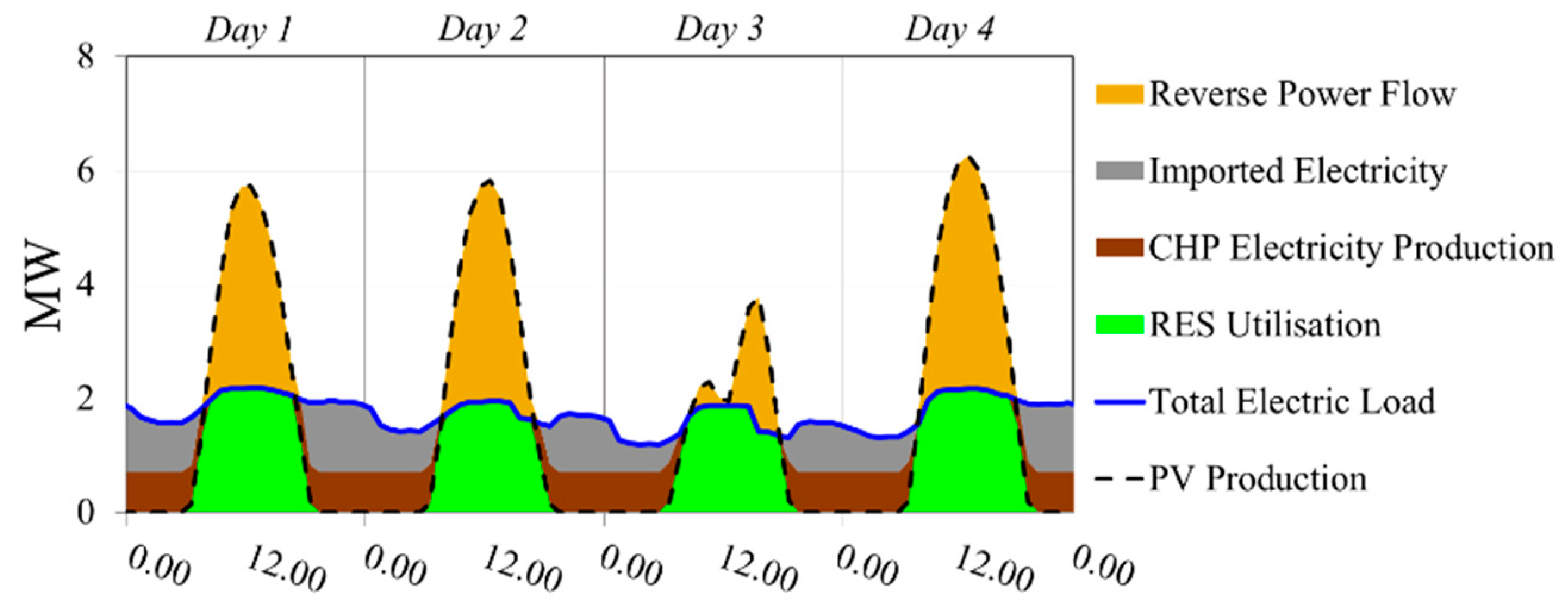
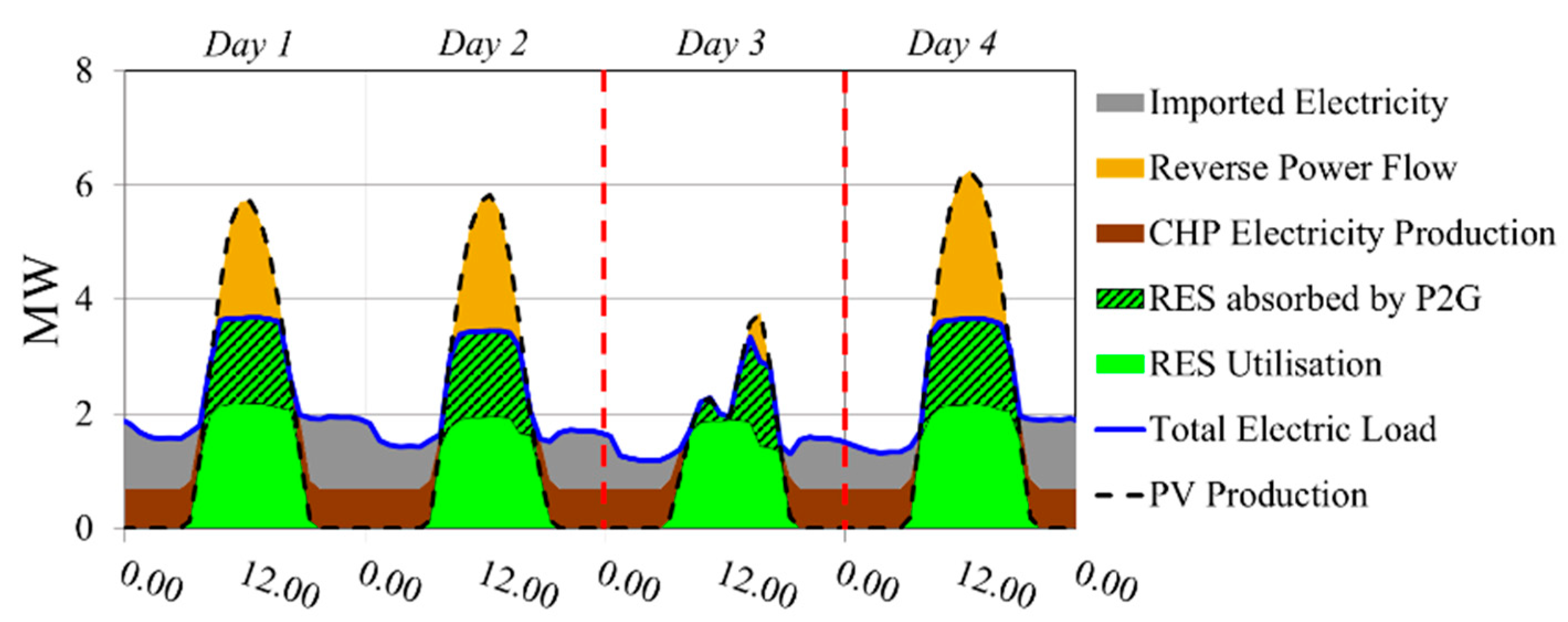

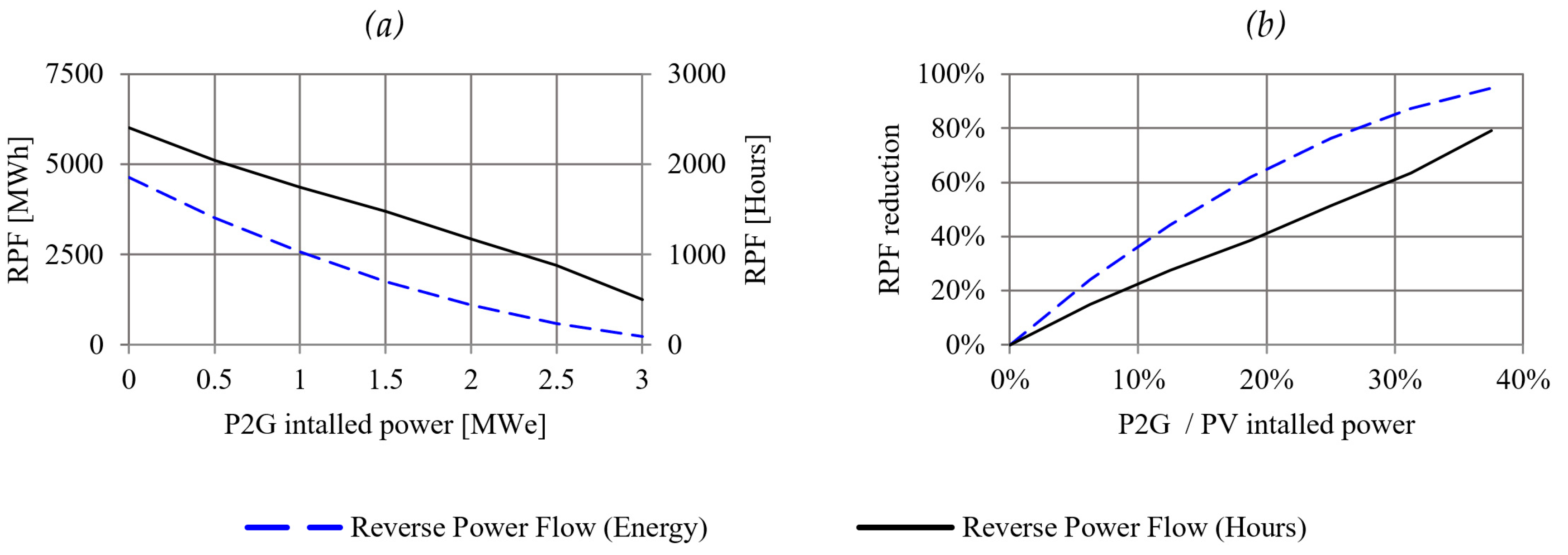

| Grid Node | Electric Peak Load [MW] | PV Nominal Power [MW] | CHP -Nominal Power [MW] | P2G-Nominal Power [MW] |
|---|---|---|---|---|
| 1 | 0.3 | 1.0 | - | - |
| 2 | 0.2 | 2.0 | - | 1.5 |
| 3 | 0.5 | - | - | - |
| 4 | 0.5 | 1.0 | 0.4 | - |
| 5 | 0.4 | 2.0 | - | - |
| 6 | 0.2 | 1.0 | - | - |
| 7 | 0.3 | 1.0 | - | - |
| 8 | 0.6 | - | 0.3 | - |
| tot | 3.0 | 8.0 | 0.7 | 1.5 |
| Parameter | Value | Unit |
|---|---|---|
| Time horizon | 1 | years |
| Location | Turin | - |
| Time step | 60 | minutes |
| DH heat peak power | 6.0 | MW |
| G2H nominal power | 6.0 | MW |
| Electrolysis efficiency [42] | 0.75 | - |
| Methanation efficiency [42] | 0.80 | - |
| CHP electric efficiency [13] | 0.40 | - |
| CHP thermal efficiency [13] | 0.45 | - |
| P2G CAPEX 1 [43] | 750–1550 | €/kWe |
| P2G OPEX 2 [43] | 4.0 | % CAPEX |
| P2G Lifetime [43] | 25 | years |
© 2019 by the authors. Licensee MDPI, Basel, Switzerland. This article is an open access article distributed under the terms and conditions of the Creative Commons Attribution (CC BY) license (http://creativecommons.org/licenses/by/4.0/).
Share and Cite
Badami, M.; Fambri, G.; Mancò, S.; Martino, M.; Damousis, I.G.; Agtzidis, D.; Tzovaras, D. A Decision Support System Tool to Manage the Flexibility in Renewable Energy-Based Power Systems. Energies 2020, 13, 153. https://doi.org/10.3390/en13010153
Badami M, Fambri G, Mancò S, Martino M, Damousis IG, Agtzidis D, Tzovaras D. A Decision Support System Tool to Manage the Flexibility in Renewable Energy-Based Power Systems. Energies. 2020; 13(1):153. https://doi.org/10.3390/en13010153
Chicago/Turabian StyleBadami, Marco, Gabriele Fambri, Salvatore Mancò, Mariapia Martino, Ioannis G. Damousis, Dimitrios Agtzidis, and Dimitrios Tzovaras. 2020. "A Decision Support System Tool to Manage the Flexibility in Renewable Energy-Based Power Systems" Energies 13, no. 1: 153. https://doi.org/10.3390/en13010153
APA StyleBadami, M., Fambri, G., Mancò, S., Martino, M., Damousis, I. G., Agtzidis, D., & Tzovaras, D. (2020). A Decision Support System Tool to Manage the Flexibility in Renewable Energy-Based Power Systems. Energies, 13(1), 153. https://doi.org/10.3390/en13010153





